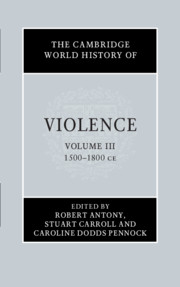Book contents
- The Cambridge World History of Violence
- The Cambridge World History of Violence
- The Cambridge World History of Violence
- Copyright page
- Contents
- Figures
- Maps
- Contributors to Volume iii
- Introduction to Volume iii
- Part I Empire, Race and Ethnicity
- Part II Cultures of War and Violence
- 6 Chinese Ways of Warfare
- 7 The Wars of Invasion in the Caribbean and Mesoamerica, 1492–1547
- 8 The Yogi’s Way of War
- 9 Warfare in Europe
- 10 War, State and the Privatisation of Violence in the Ottoman Empire
- Part III Intimate and Gendered Violence
- Part IV The State, Punishment and Justice
- Part V Popular Protest and Resistance
- Part VI Religious and Sacred Violence
- Part VII Representations and Constructions of Violence
- Index
- References
7 - The Wars of Invasion in the Caribbean and Mesoamerica, 1492–1547
from Part II - Cultures of War and Violence
Published online by Cambridge University Press: 13 March 2020
- The Cambridge World History of Violence
- The Cambridge World History of Violence
- The Cambridge World History of Violence
- Copyright page
- Contents
- Figures
- Maps
- Contributors to Volume iii
- Introduction to Volume iii
- Part I Empire, Race and Ethnicity
- Part II Cultures of War and Violence
- 6 Chinese Ways of Warfare
- 7 The Wars of Invasion in the Caribbean and Mesoamerica, 1492–1547
- 8 The Yogi’s Way of War
- 9 Warfare in Europe
- 10 War, State and the Privatisation of Violence in the Ottoman Empire
- Part III Intimate and Gendered Violence
- Part IV The State, Punishment and Justice
- Part V Popular Protest and Resistance
- Part VI Religious and Sacred Violence
- Part VII Representations and Constructions of Violence
- Index
- References
Summary
This chapter critically examines early sixteenth-century Spanish slave-raiding and invasion-related violence in the Caribbean and Mesoamerica, emphasising the varied ways whereby indigenous peoples sought to mitigate, incorporate or reject the newcomers’ presence in the region. It begins with Columbus’s 1492 voyage and subsequent Spanish slaving activities in the Caribbean, then turns to the Spanish–Aztec War that devastated central Mexico, before closing with a discussion of the ‘Thirty Years War’ that disrupted Maya kingdoms. By connecting disparate flashpoints of war, high mortality rates, the enslavement of indigenous peoples and internal displacement, the long and complex tradition of violence that underpinned Spanish efforts to subjugate Aztecs, Mayas and hundreds of thousands of other indigenous peoples will be explored. Patterns to violence and warfare, however, were not unilateral; the leaders of indigenous Caribbean and Mesoamerica polities utilised violence according to their own customs and agendas. These particular wars of invasion and conquest can therefore be understood as part of a larger, multifaceted process.
- Type
- Chapter
- Information
- The Cambridge World History of Violence , pp. 138 - 155Publisher: Cambridge University PressPrint publication year: 2020
References
Bibliographic Essay
- 1
- Cited by

